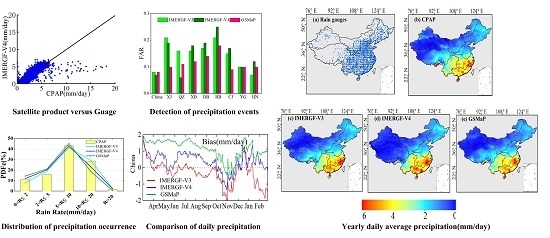Comprehensive Evaluation of Two Successive V3 and V4 IMERG Final Run Precipitation Products over Mainland China
Abstract
:1. Introduction
2. Study Area and Data Products
2.1. Study Area
2.2. Gauge-Observed Data
2.3. Satellite-Based Precipitation Products
2.3.1. IMERG Products
2.3.2. Version 6 GSMaP Products
3. Evaluation Metrics
4. Results
4.1. Annual Daily Average Precipitation
4.2. Seasonal Daily Average Precipitation
4.3. Daily Precipitation
4.4. Probability Distribution Function (PDF) Analysis
4.5. Contingency Statistics
5. Discussion
6. Conclusions
- (1)
- Overall, the IMERGF-V4 product does not exhibit the expected superior performance compared to the IMERGF-V3 product over China. For the annual daily average precipitation, the IMERGF-V4 product shows a significant underestimation of the precipitation in the western regions (e.g., QZ and XJ), while the IMERGF-V3 product has a better RB performance than the IMERGF-V4 product (3.70% for IMERGF-V3 vs. −7.18% for IMERGF-V4) over China. Additionally, the IMERGF-V3 product has a higher CC (0.91), a smaller RMSE (0.63 mm/day), and a lower FSE (0.49); correspondingly, the IMERGF-V4 product has a lower CC (0.89), a larger RMSE (0.72 mm/day), and a higher FSE (0.56). In comparison, the GSMaP product performs better in terms of spatial precipitation distribution than the IMERGF-V3 and V4 products with the highest CC (0.95), the smallest RMSE (0.47 mm/day), the lowest FSE (0.37), and the highest RB (−2.39%) at an annual scale.
- (2)
- For the seasonal analysis over China, the absolute RBs of the IMERGF-V4 product are slightly improved during spring and summer but have lower values than the IMERGF-V3 product during autumn and winter (Appendix C). The IMERGF-V3 product has a better performance than the IMERGF-V4 product for the CC, RMSE, and FSE during summer, autumn, and winter but produces inferior FSE values during spring (0.63 vs. 0.41). Among the three satellite-based products, the GSMaP product obtains the best RMSE, FSE, and CC during all four seasons and obtains the worst RB values during spring and winter (−5.90% during spring and −17.02% during winter).
- (3)
- The IMERGF-V3 and IMERGF-V4 products show a distinct underestimation over XJ and YG most of the time. In QZ, the IMERGF-V4 product produces significant underestimations compared to the IMERGF-V3 product during all four seasons (Appendix D). Additionally, the IMERGF-V3 product achieves better metrics (i.e., better RB, RMSE, FSE, and CC) during winter, especially in the western, arid region and in the North.
- (4)
- For the daily statistical metrics, although IMERGF-V4 has similar performance than its predecessor IMERGF-V3 over southern China, eastern China and north-eastern China, it presents considerable improvement over IMERGF-V3 during autumn and winter in the drier north-western China (XJ and XB) regions. However, IMERGF-V4 yields a strong underestimation in the high-altitude region (QZ) in comparison with IMERGF-V3. Compared to IMERGF-V3 and V4, the GSMaP bias values exhibit underestimations in warmer seasons (from April to September) in most regions (except for QZ) and perform better during colder seasons (from October 2014 to February 2015).
- (5)
- Compared to the IMERGF-V3 product, the IMERGF-V4 product has slightly higher POD and PSS scores only over HB, CJ, and HN (Figure 9). In addition to XJ and QZ, the IMERGF-V3 product has more false rainfall event estimations based on FAR. In QZ, the FBI results show that the IMERGF-V3 product slightly overestimates the rainfall events and the IMERGF-V4 product arrives at significant underestimations. The absolute TE value for the IMERGF-V4 product is significantly larger than that of the IMERGF-V3 product in QZ. Among the three precipitation products, the GSMaP product generally arrives at better scores for the POD, FAR, PSS, and TE for most regions (except for XJ).
- (6)
- Judging by the PDFc and PDFv, when the CPAP rainfall intensity exceeds 10 mm/day, the IMERGF-V4 product underestimates the precipitation events over XJ and QZ compared to the IMERGF-V3 product. The updated IMERGF-V4 product heavily underestimates precipitation when the rain rate is in the range of 5–10 mm/day and has an apparent overestimation in the range of 2–5 mm/day over QZ compared to the IMERGF-V3 product. The GSMaP product detects relatively more light precipitation events (<2 mm/day) in most areas and less heavy precipitation events (>10 mm/day) over XJ, XB, DB, HB, and CJ.
- (7)
- This study compares the similarities and differences between the successive V3 and V4 IMERGF products over China and provides important reference information for future hydrological and climatic applications. The results of the error analysis of the IMERGF-V3 and V4 products provide helpful feedback to IMERG algorithm developers to improve product accuracies in future. Although the IMERGF-V4 product does not show an anticipated improvement over the IMERGF-V3 product in China, additional studies are required to evaluate the V4 product elsewhere.
Acknowledgments
Author Contributions
Conflicts of Interest
Appendix A. The 2 × 2 Contingency Table Used for the Computation of Categorical Metrics
| Estimated | Observed | ||
| Rain (Daily rain ≥ 0.5 mm) | No-rain (Daily rain < 0.5 mm) | ||
| Rain (Daily rain ≥ 0.5 mm) | Hits | False alarms | Estimated events |
| No-rain (Daily rain < 0.5 mm) | Misses | Correct negatives | Estimated non-events |
| Observed events | Observed non-events |
Appendix B. The Statistical Metrics Used in the Evaluation and Comparison
| Metrics | Equations |
| Correlation coefficient (CC) | |
| Bias | |
| Relative bias (RB) | |
| Root-mean-square error (RMSE) | |
| Fractional Standard Error (FSE) | |
| Probability of Detection (POD) | |
| False Alarm Ratio (FAR) | |
| Frequency Bias Index (FBI) | |
| Peirce Skill Score (PSS) | |
| Total Error (TE) |
Appendix C. Statistical Metrics for Annual Daily Average Satellite Precipitation over the 8 Sub-Regions in China
| Metrics | Products | XJ | QZ | XB | DB | HB | CJ | YG | HN |
| RB (%) | IMERGF-V3 | −17.74 | 3.32 | 8.44 | 11.20 | 13.34 | 4.49 | −5.13 | 7.66 |
| IMERGF-V4 | −37.63 | −60.91 | 3.21 | 8.51 | 12.35 | 7.12 | −8.34 | 7.57 | |
| GSMaP | −33.61 | −4.65 | −0.75 | −3.54 | 6.32 | 0.61 | −4.08 | 2.16 | |
| RMSE (mm/day) | IMERGF-V3 | 0.29 | 0.43 | 0.20 | 0.25 | 0.32 | 0.54 | 1.50 | 0.75 |
| IMERGF-V4 | 0.36 | 0.84 | 0.21 | 0.27 | 0.31 | 0.54 | 1.50 | 0.72 | |
| GSMaP | 0.27 | 0.31 | 0.16 | 0.22 | 0.25 | 0.40 | 1.07 | 0.54 | |
| CC | IMERGF-V3 | 0.67 | 0.83 | 0.93 | 0.81 | 0.94 | 0.86 | 0.42 | 0.61 |
| IMERGF-V4 | 0.50 | 0.75 | 0.91 | 0.78 | 0.93 | 0.88 | 0.46 | 0.66 | |
| GSMaP | 0.83 | 0.92 | 0.94 | 0.81 | 0.94 | 0.91 | 0.79 | 0.78 | |
| FSE | IMERGF-V3 | 0.45 | 0.42 | 0.21 | 0.21 | 0.24 | 0.28 | 0.83 | 0.36 |
| IMERGF-V4 | 0.57 | 0.82 | 0.22 | 0.22 | 0.24 | 0.28 | 0.83 | 0.34 | |
| GSMaP | 0.43 | 0.30 | 0.17 | 0.18 | 0.19 | 0.20 | 0.59 | 0.26 |
Appendix D. Statistical Metrics for Seasonal Daily Average Precipitation over the 8 Sub-Regions in China
| Metrics | Seasons | Datasets | XJ | QZ | XB | DB | HB | CJ | YG | HN |
| RB (%) | Spring | IMERGF-V3 | −14.59 | 18.64 | 8.22 | 8.40 | 4.43 | 6.62 | −8.19 | 11.48 |
| IMERGF-V4 | −44.51 | −72.33 | −0.66 | 11.33 | 6.12 | 7.41 | −15.55 | 10.30 | ||
| GSMaP | −46.11 | −6.26 | −11.91 | −19.76 | −2.54 | 0.66 | −9.95 | 4.83 | ||
| Summer | IMERGF-V3 | −46.47 | −1.55 | 16.59 | 16.18 | 16.54 | 1.47 | 1.07 | 13.13 | |
| IMERGF-V4 | −3.57 | −58.19 | 15.62 | 15.26 | 15.93 | 6.18 | −1.01 | 11.18 | ||
| GSMaP | −16.55 | −1.64 | 8.30 | 4.29 | 9.41 | 1.41 | −0.13 | 5.80 | ||
| Autumn | IMERGF-V3 | −12.82 | 10.92 | 3.15 | 15.81 | 15.43 | 7.85 | −10.79 | 0.21 | |
| IMERGF-V 4 | −56.87 | −65.30 | −14.75 | −0.82 | 2.74 | 2.26 | −20.02 | 2.35 | ||
| GSMaP | −42.19 | −8.09 | −5.49 | −2.22 | 8.70 | 5.23 | −5.57 | −4.77 | ||
| Winter | IMERGF-V3 | −46.89 | 2.72 | −59.81 | −35.70 | 13.24 | 4.12 | −28.66 | −16.25 | |
| IMERGF-V4 | −95.14 | −63.74 | −79.94 | −55.91 | 8.37 | 10.18 | −32.94 | −17.37 | ||
| GSMaP | −49.24 | −27.86 | −38.14 | −28.83 | 4.84 | −7.44 | −16.71 | −10.92 | ||
| RMSE (mm/day) | Spring | IMERGF-V3 | 0.46 | 0.51 | 0.23 | 0.33 | 0.35 | 0.90 | 1.65 | 1.23 |
| IMERGF-V4 | 0.48 | 0.63 | 0.26 | 0.49 | 0.33 | 0.84 | 1.61 | 1.29 | ||
| GSMaP | 0.43 | 0.26 | 0.19 | 0.43 | 0.31 | 0.66 | 1.39 | 1.05 | ||
| Summer | IMERGF-V3 | 0.64 | 1.03 | 0.61 | 0.78 | 0.72 | 1.26 | 3.86 | 1.91 | |
| IMERGF-V4 | 0.67 | 2.01 | 0.62 | 0.85 | 0.74 | 1.14 | 3.95 | 1.73 | ||
| GSMaP | 0.45 | 0.79 | 0.47 | 0.58 | 0.67 | 1.14 | 2.78 | 1.45 | ||
| Autumn | IMERGF-V3 | 0.37 | 0.50 | 0.32 | 0.35 | 0.57 | 0.58 | 0.98 | 0.97 | |
| IMERGF-V4 | 0.50 | 0.71 | 0.34 | 0.29 | 0.48 | 0.53 | 1.05 | 0.95 | ||
| GSMaP | 0.41 | 0.37 | 0.25 | 0.28 | 0.41 | 0.48 | 0.68 | 0.71 | ||
| Winter | IMERGF-V3 | 0.30 | 0.42 | 0.20 | 0.25 | 0.10 | 0.34 | 0.46 | 0.54 | |
| IMERGF-V4 | 0.35 | 0.48 | 0.22 | 0.33 | 0.11 | 0.33 | 0.46 | 0.59 | ||
| GSMaP | 0.23 | 0.23 | 0.18 | 0.21 | 0.08 | 0.25 | 0.35 | 0.37 | ||
| CC | Spring | IMERGF-V3 | 0.48 | 0.72 | 0.88 | 0.64 | 0.94 | 0.95 | 0.66 | 0.91 |
| IMERGF-V4 | 0.48 | 0.67 | 0.83 | 0.37 | 0.95 | 0.93 | 0.70 | 0.89 | ||
| GSMaP | 0.70 | 0.92 | 0.93 | 0.69 | 0.95 | 0.95 | 0.80 | 0.91 | ||
| Summer | IMERGF-V3 | 0.46 | 0.85 | 0.88 | 0.75 | 0.83 | 0.79 | 0.35 | 0.62 | |
| IMERGF-V4 | 0.26 | 0.73 | 0.86 | 0.71 | 0.81 | 0.85 | 0.32 | 0.64 | ||
| GSMaP | 0.72 | 0.91 | 0.92 | 0.74 | 0.79 | 0.84 | 0.79 | 0.71 | ||
| Autumn | IMERGF-V3 | 0.72 | 0.74 | 0.87 | 0.80 | 0.89 | 0.84 | 0.80 | 0.83 | |
| IMERGF-V4 | 0.61 | 0.78 | 0.88 | 0.81 | 0.88 | 0.86 | 0.83 | 0.84 | ||
| GSMaP | 0.76 | 0.87 | 0.94 | 0.81 | 0.93 | 0.89 | 0.90 | 0.92 | ||
| Winter | IMERGF-V3 | 0.40 | 0.40 | 0.23 | 0.35 | 0.93 | 0.91 | 0.78 | 0.62 | |
| IMERGF-V4 | 0.29 | 0.38 | 0.07 | 0.13 | 0.92 | 0.94 | 0.83 | 0.49 | ||
| GSMaP | 0.82 | 0.56 | 0.33 | 0.43 | 0.94 | 0.96 | 0.85 | 0.80 | ||
| FSE | Spring | IMERGF-V3 | 0.83 | 0.69 | 0.28 | 0.30 | 0.27 | 0.41 | 1.09 | 0.51 |
| IMERGF-V4 | 0.85 | 0.86 | 0.31 | 0.44 | 0.26 | 0.38 | 1.05 | 0.53 | ||
| GSMaP | 0.76 | 0.52 | 0.23 | 0.38 | 0.24 | 0.30 | 0.91 | 0.43 | ||
| Summer | IMERGF-V3 | 0.81 | 0.64 | 0.46 | 0.44 | 0.44 | 0.52 | 1.48 | 0.70 | |
| IMERGF-V4 | 0.84 | 1.24 | 0.46 | 0.49 | 0.45 | 0.47 | 1.52 | 0.63 | ||
| GSMaP | 0.57 | 0.49 | 0.35 | 0.33 | 0.41 | 0.47 | 1.07 | 0.53 | ||
| Autumn | IMERGF-V3 | 0.56 | 0.58 | 0.33 | 0.33 | 0.39 | 0.35 | 0.58 | 0.59 | |
| IMERGF-V4 | 0.76 | 0.82 | 0.34 | 0.27 | 0.33 | 0.32 | 0.61 | 0.57 | ||
| GSMaP | 0.63 | 0.42 | 0.25 | 0.26 | 0.28 | 0.29 | 0.40 | 0.43 | ||
| Winter | IMERGF-V3 | 0.61 | 0.94 | 0.52 | 0.42 | 0.19 | 0.28 | 0.50 | 0.41 | |
| IMERGF-V4 | 0.73 | 1.08 | 0.57 | 0.54 | 0.21 | 0.27 | 0.50 | 0.45 | ||
| GSMaP | 0.47 | 0.52 | 0.47 | 0.35 | 0.16 | 0.21 | 0.38 | 0.28 |
References
- Arkin, P.A.; Xie, P. The Global Precipitation Climatology Project: First Algorithm Intecomparison Project. Bull. Am. Meteorol. Soc. 1994, 75, 401–419. [Google Scholar] [CrossRef]
- Bitew, M.M.; Gebremichael, M.; Gebremichael, L.T.; Bayissa, Y.A. Evaluation of high-resolution satellite rainfall products through streamflow simulation in a hydrological modeling of a small mountainous watershed in Ethiopia. J. Hydrometeorol. 2012, 13, 338–350. [Google Scholar] [CrossRef]
- Chintalapudi, S.; Sharif, H.O.; Xie, H.J. Sensitivity of distributed hydrologic simulations to ground and satellite based rainfall products. Water 2014, 6, 1221–1245. [Google Scholar] [CrossRef]
- Hong, Y.; Adler, R.F.; Negri, A.; Huffman, G.J. Flood and landslide applications of near real-time satellite rainfall products. Nat. Hazards 2007, 43, 285–294. [Google Scholar] [CrossRef]
- Kidd, C.; Bauer, P.; Turk, J.; Braithwaite, D. Intercomparison of high-resolution precipitation products over Northwest Europe. J. Hydrometeorol. 2012, 13, 67–83. [Google Scholar] [CrossRef]
- Sahlu, D.; Nikolopoulos, E.; Moges, E.; Anagnostou, E.; Hailu, D. First evaluation of the Integrated Multi-satellitE Retireval for GPM Day-1 IMERG over the upper Blue Nile Basin. J. Hydrometeorol. 2016. [Google Scholar] [CrossRef]
- Wang, H.L.; Guan, H.D.; Gutiérrez-Jurado, H.A.; Simmons, C.T. Examination of water budget using satellite products over Australia. J. Hydrol. 2014, 511, 546–554. [Google Scholar] [CrossRef]
- Zhang, W.J.; Zhang, Y.J.; Zhou, X.J. Lightning activity and precipitation characteristics of typhoon Molave around its landfall. Acta Meteorol. Sin. 2009, 27, 742–757. [Google Scholar] [CrossRef]
- Habib, E.; Haile, A.T.; Tian, Y.; Joyce, R.J. Evaluation of the high-resolution CMORPH satellite rainfall product using dense rain gauge observations and radar-based estimates. J. Hydrometeorol. 2012, 13, 1784–1798. [Google Scholar] [CrossRef]
- Khan, S.I.; Adhikari, P.; Hong, Y.; Vergara, H.; Aldler, R.F.; Policelli, F.; Irwin, D.; Korme, T.; Okello, L. Hydroclimatology of Lake Victoria region using hydrologic model and satellite remote sensing data. Hydrol. Earth Syst. Sci. 2011, 15, 107–117. [Google Scholar] [CrossRef]
- Khan, S.I.; Hong, Y.; Wang, J.H.; Yilmaz, K.K.; Gourley, J.J.; Adler, R.F.; Brakenridge, G.R.; Policelli, F.; Habib, S.; Irwin, D. Satellite remote sensing and hydrologic modeling for flood inundation mapping in Lake Victoria basin: Implications for hydrologic prediction in ungauged basins. IEEE Trans. Geosci. Remote Sens. 2011, 49, 85–95. [Google Scholar] [CrossRef]
- Zappa, M.; Fundel, F.; Jaun, S. A ‘Peak-Box’ approach for supporting interpretation and verification of operational ensemble peak-flow forecasts. Hydrol. Process. 2013, 27, 117–131. [Google Scholar] [CrossRef]
- Zhang, Y.; Hong, Y.; Wang, X.G.; Gourley, J.J.; Xue, X.W.; Saharia, M.; Ni, G.; Wang, G.; Huang, Y.; Chen, S.; et al. Hydrometeorological analysis and remote sensing of extremes: Was the July 2012 Beijing flood event detectable and predictable by Global Satellite Observing and Global Weather Modeling Systems? Am. Meteorol. Soc. 2015, 16, 381–395. [Google Scholar] [CrossRef]
- Ciach, G.J.; Krajewski, W.F.; Villarini, G. Product-error-driven uncertainty model for probabilistic quantitative precipitation estimation with NEXRAD data. J. Hydrometeorol. 2007, 8, 1325–1347. [Google Scholar] [CrossRef]
- Duan, Z.; Liu, J.; Tuo, Y.; Chiogna, C.; Disse, M. Evaluation of eight high spatial resolution gridded precipitation products in Adige Basin (Italy) at multiple temporal and spatial scales. Sci. Total Environ. 2016, 573, 1536–1553. [Google Scholar] [CrossRef] [PubMed]
- Ebert, E.E.; Janowiak, J.E.; Kidd, C. Comparison of near-real-time precipitation estimates from satellite observations and numerical models. Bull. Am. Meteorol. Soc. 2007, 88, 47–64. [Google Scholar] [CrossRef]
- Lo Conti, F.; Hsu, K.L.; Noto, L.V.; Sorooshian, S. Evaluation and comparison of satellite precipitation estimates with reference to local area in the Mediteranean Sea. Atmos. Res. 2014, 138, 189–204. [Google Scholar] [CrossRef]
- Jiang, S.H.; Zhou, M.; Ren, L.L.; Cheng, X.R.; Zhang, P.J. Evaluation of latest TMPA and CMORPH satellite precipitation products over Yellow River Basin. Water Sci. Eng. 2016, 9, 87–96. [Google Scholar] [CrossRef]
- Mei, Y.W.; Anagnostou, E.N.; Nikolopoulos, E.I.; Borga, M. Error analysis of satellite precipitation products in mountainous basins. J. Hydrometeorol. 2014, 15, 1778–1793. [Google Scholar] [CrossRef]
- Nan, Z.T.; Wang, S.G.; Liang, X.; Adams, T.E.; Teng, W.; Liang, Y. Analysis of spatial similarities between NEXRAD and NLDAS precipitation data products. IEEE Sel. Top. Appl. Earth Obs. Remote Sens. 2010, 3, 371–385. [Google Scholar] [CrossRef]
- Ning, S.W.; Wang, J.; Jin, J.L.; Ishidaira, H. Assessment of the latest GPM-Era high-resolution satellite precipitation products by comparison with Observation Gauge Data over the Chinese Mainland. Water 2016, 8, 481. [Google Scholar] [CrossRef]
- Porcù, F.; Milani, L.; Petracca, M. On the uncertainties in validating satellite instantaneous rainfall estimates with raingauge operational network. Atmos. Res. 2014, 144, 73–81. [Google Scholar] [CrossRef]
- Schneebeli, M.; Dawes, N.; Lehning, M.; Berne, A. High-resolution vertical profiles of X-band polarimetric radar observables during snowfall in the Swiss Alps. J. Appl. Meteorol. Climatol. 2013, 52, 378–394. [Google Scholar] [CrossRef]
- Skofronick-Jackson, G.; Petersen, W.A.; Berg, W.; Kidd, C.F.; Stocker, E.; Kirschbaum, D.B.; Kakar, R.; Braun, S.A.; Huffman, G.J.; Iguchi, T.; et al. The Global Precipitation Measurement (GPM) mission for science and society. Bull. Am. Meteorol. Soc. 2016. [Google Scholar] [CrossRef]
- Kubota, T.; Seto, S.; Awaka, J.; Kida, S.; Oki, R. Evaluation of precipitation estimation by at-Launch codes of GPM/DPR algorithms using synthetic data from TRMM/PR observations. IEEE J. Sel. Top. Appl. Obs. Remote Sens. 2014, 7, 3931–3944. [Google Scholar] [CrossRef]
- Huffman, G.J.; Bolvin, D.T.; Braithwaite, D.; Hsu, K.; Joyce, R.; Xie, P. Algorithm Theoretical Basis Document (ATBD) Version 4.5 NASA Global Precipitation Measurement (GPM) Integrated Multi-satellitE Retrievals for GPM (IMERG). NASA, 2015. Available online: https://pmm.nasa.gov/index.php?q=data-access/downloads/gpm/IMERGAlgorithmTheoreticalBasisDocument(ATBD) (accessed on 11 June 2015).
- Huffman, G.J.; Bolvin, D.T.; Braithwaite, D.; Hsu, K.; Joyce, R.; Xie, P. Algorithm Theoretical Basis Document (ATBD) Version 4.4 for the NASA Global Precipitation Measurement (GPM) Integrated Multi-satellitE Retrievals for GPM (I-MERG). NASA, 2014. Available online: http:/pmm.nasa.gov/sites/default/files/document_files/IMERG_ATBD_V4.4.pdf (accessed on 26 April 2014).
- Yong, B.; Liu, D.; Gourley, J.J.; Tian, Y.D.; Huffman, G.J.; Ren, L.L.; Hong, Y. Global view of real-time TRMM multisatellite precipitation analysis: Implications for its successor global precipitation measurement mission. Bull. Am. Meteorol. Soc. 2015, 96, 283–296. [Google Scholar] [CrossRef]
- Huffman, G.J.; Adler, R.F.; Bolvin, D.T.; Gu, G.; Nelkin, E.J.; Bowman, K.P.; Hong, Y.; Stocker, E.F.; Wolff, D.B. The TRMM Multisatellite Precipitation Analysis (TMPA): Quasi-global, multiyear, combined-sensor precipitation estimates at fine scales. J. Hydrometeorol. 2007, 8, 38–55. [Google Scholar] [CrossRef]
- Joyce, R.J.; Xie, P. Kalman filter-based CMORPH. J. Hydrometeorol. 2011, 12, 1547–1563. [Google Scholar] [CrossRef]
- Hong, Y.; Hsu, K.L.; Sorooshian, S.; Gao, X.G. Precipitation estimation from remotely sensed imagery using an Artificial Neural Network Cloud Classification System. J. Appl. Meteorol. 2004, 43, 1834–1852. [Google Scholar] [CrossRef]
- Huffman, G.J.; Bolvin, D.T.; Braithwaite, D.; Hsu, K.; Joyce, R.; Kidd, C.; Nelkin, E.J.; Sorooshian, S.; Tan, J.; Xie, P. Algorithm Theoretical Basis Document (ATBD) Version 4.6 NASA Global Precipitation Measurement (GPM) Integrated Multi-satellitE Retrievals for GPM (IMERG). NASA, 2017. Available online: https://pmm.nasa.gov/index.php?q=data-access/downloads/gpm (accessed on 18 June 2017).
- Huffman, G.J.; Bolvin, D.T.; Nelkin, E.J.; Stocher, E.F. V04 IMERG Final Run Release Notes. NASA 1–2. 2017. Available online: https://pmm.nasa.gov/data-access/downloads/gpm/V04IMERGFinalRunReleaseNotes (accessed on 18 June 2017).
- Chen, F.R.; Li, X. Evaluation of IMERG and TRMM 3B43 monthly precipitation products over Mainland China. Remote Sens. 2016, 8, 472. [Google Scholar] [CrossRef]
- Guo, H.; Chen, S.; Bao, A.M.; Behrangi, A.L.; Hong, Y.; Ndayisaba, F.; Hu, J.; Phillip, M. Stepanian Early assessment of Integrated multi-satellitE Retrievals for Global Precipitation Measurement over China. Atmos. Res. 2016, 176–177, 121–133. [Google Scholar] [CrossRef]
- Li, N.; Tang, G.Q.; Zhao, P.; Hong, Y.; Gou, Y.B.; Yang, K. Statistical assessment and hydrological utility of the latest multi-satellite precipitation analysis IMERG in Ganjiang River basin. Atmos. Res. 2017, 183, 212–223. [Google Scholar] [CrossRef]
- Pakoksung, K.; Takagi, M. Effects of satellite based rainfall products on river basin responses of runoff simulation on flood event. Model. Earth Syst. Environ. 2016, 2, 143. [Google Scholar] [CrossRef]
- Prakash, S.; Mitra, A.K.; AghaKouchak, A.; Liu, Z.; Norouzi, H.; Pai, D.S. A preliminary assessment of GPM-based multi-satellite precipitation estimates over a monsoon dominated region. J. Hydrol. 2016. [Google Scholar] [CrossRef]
- Prakash, S.; Mitra, A.K.; Pai, D.S.; AghaKouchak, A. From TRMM to GPM: How well can heavy rainfall be detected from space? Adv. Water Resour. 2016, 88, 1–7. [Google Scholar] [CrossRef]
- Tang, G.Q.; Ma, Y.Z.; Long, D.; Zhong, L.Z.; Hong, Y. Evaluation of GPM Day-1 IMERG and TMPA Version-7 legacy products over Mainland China at multiple spatiotemporal scales. J. Hydrol. 2016, 533, 152–167. [Google Scholar] [CrossRef]
- Tang, G.Q.; Zeng, Z.Y.; Long, D.; Guo, X.L. Statistical and hydrological comparisons between TRMM and GPM Level-3 Products over a midlatitude basin: Is Day-1 IMERG a good successor for TMPA 3B42V7? Bull. Am. Meteorol. Soc. 2016, 7, 121–137. [Google Scholar] [CrossRef]
- Ushio, T.; Kubota, T.; Shige, S.; Okamoto, R.; Aonashi, K.; Inoue, T.; Takahashi, N.; Iguchi, T.; Kachi, M.; Oki, R.; et al. A Kalman filter approach to the Global Satellite Mapping of Precipitation (GSMaP) from combined passive microwave and infrared radiometric data. J. Meteorol. Soc. Jpn. 2009, 87A, 137–151. [Google Scholar] [CrossRef]
- Chen, S.; Hong, Y.; Cao, Q.; Gourley, J.J.; Kirstetter, P.E.; Yong, B.; Tian, Y.; Zhang, Z.; Shen, Y.; Hu, J.; et al. Similarity and difference of the two successive V6 and V7 TRMM multisatellite precipitation analysis performance over China. J. Geophys. Res. Atmos. 2013, 118, 13060–13074. [Google Scholar] [CrossRef]
- Shen, Y.; Xiong, A.; Wang, Y.; Xie, P. Performance of highresolution satellite precipitation products over China. J. Geophys. Res. 2010, 115, D02114. [Google Scholar] [CrossRef]
- Liang, J. Study of the Influences of Monsoon Gyres on Formation and Sudden Track Change of Typhoons. Master’s Thesis, College of Atmospheric Science, Nanjing University of Information Science & Technology, Nanjing, China, 2012. [Google Scholar]
- Bothe, O.; Fraedrich, K.; Zhu, X. Precipitation climate of central Asia and the large-scale atmospheric circulation. Theor. Appl. Climatol. 2012, 108, 345–354. [Google Scholar] [CrossRef]
- Shen, Y.; Feng, M.; Zhang, H.; Gao, F. Interpolationmethods of China daily precipitation data. J. Appl. Meteorol. Sci. 2010, 21, 279–281. (In Chinese) [Google Scholar]
- Tian, Y.; Peters-Lidard, C.; Eylander, J.; Joyce, R.; Huffman, G.; Adler, R.; Hsu, K.-L.; Turk, F.J.; Garcia, M.; Zeng, J. Component analysis of errors in satellitebased precipitation estimates. J. Geophys. Res. 2009, 114, D24101. [Google Scholar] [CrossRef]
- Hogan, R.J.; Ferro, C.A.T.; Jolliffe, I.T.; Stephenson, D.B. Equitability revisited: Why the “Equitable Threat Score” is not equitable. Weather Forecast. 2010, 25, 710–726. [Google Scholar] [CrossRef]
- Mu, J.L.; Li, Z.C.; Chen, Y.; Chen, X.P. Feature analyses of mesoscale convective system of a heavy rainfall in the Central Shaanxi Plain. Plateau Meteorol. 2014, 33, 148–161. (In Chinese) [Google Scholar]
- Hur, J.; Raghavan, S.V.; Nguyen, N.S.; Liong, S.Y. Evaluation of high-resolution satellite rainfall data over Singapore. Procedia Eng. 2016, 154, 158–167. [Google Scholar] [CrossRef]
- Amlien, J. Remote Sensing of Snow with Passive Microwave Radiometers: A Review of Current Algorithms; Report No. 1019; Norsk Regnesentral: Oslo, Norway, 2008; pp. 1–52. [Google Scholar]
- Scheel, M.L.M.; Rohrer, M.; Huggel, C.H.; Villar, D.S.; Silvestre, E.; Huffman, G.J. Evaluation of TRMM multi-satellite precipitation analysis (TMPA) performance in the central Andes region and its dependency on spatial and temporal resolution. Hydrol. Earth. Syst. Sci. 2011, 15, 2649–2663. [Google Scholar] [CrossRef] [Green Version]
- Hong, Y.; Gochis, D.; Cheng, J.; Hsu, K.; Sorooshian, S. Evaluation of PERSIANN-CCS rainfall measurement using the NAME event rain gauge network. J. Hydrometeorol. 2007, 8, 469–482. [Google Scholar] [CrossRef]
- Dinku, T.; Chidzambwa, S.; Ceccato, P.; Connor, S.J.; Ropelewski, C.F. Validation of high-resolution satellite rainfall products over complex terrain. Int. J. Remote Sens. 2008, 29, 4097–4110. [Google Scholar] [CrossRef]
- Li, X.H.; Zhang, Q.; Xu, C.Y. Assessing the performance of satellite-based precipitation products and its dependence on topography over Poyang Lake basin. Theor. Appl. Climatol. 2014, 115, 713–729. [Google Scholar] [CrossRef]
- Ning, S.W.; Song, F.; Udmale, P.; Jin, J.L.; Thapa, B.R.; Ishidaira, H. Error analysis and evaluation of the latest GSMap and IMERG precipitation products over Eastern China. Adv. Meteorol. 2017, 2017. [Google Scholar] [CrossRef]
- Adeyewa, Z.D.; Nakamura, K. Validation of TRMM radar rainfall data overmajor climatic regions in Africa. J. Appl. Meteorol. 2003, 42, 331–347. [Google Scholar] [CrossRef]
- Karaseva, M.O.; Prakash, S.; Gairola, R.M. Validation of high-resolution TRMM-3B43 precipitation product using rain gauge measurement over Kyrgyzstan. Theor. Appl. Climatol. 2012, 108, 147–157. [Google Scholar] [CrossRef]
- Taniguchi, A.; Shige, S.; Yamamoto, M.K.; Mega, T.; Kida, S.; Kubota, T.; Kachi, M.; Ushio, T.; Aonashi, K. Improvement of high-resolution satellite rainfall product for typhoon Morakot (2009) over Taiwan. J. Hydrometeorol. 2013, 14, 1859–1871. [Google Scholar] [CrossRef]
- Ferraro, R.R.; Smith, E.A.; Berg, W.; Huffman, G.J. A screening methodology for passive microwave precipitation retrieval algorithms. J. Atmos. Sci. 1998, 55, 1583–1600. [Google Scholar] [CrossRef]
- Tian, Y.; Peters-Lidard, C.D.; Choudhury, B.J.; Garcia, M. Multitemporal analysis of TRMM-based satellite precipitation products for land data assimilation applications. J. Hydrometeorol. 2007, 8, 1165–1183. [Google Scholar] [CrossRef]
- Xie, P.P.; Arkin, P.A. An intercomparison of gauge observations and satellite estimates on monthly precipitation. J. Appl. Meteorol. Climatol. 1995, 34, 1143–1160. [Google Scholar] [CrossRef]
- Li, Z.; Yang, D.W.; Hong, Y. Multi-scale evaluation of high-resolution multi-sensor blended global precipitation products over the Yangtze River. J. Hydrol. 2013, 500, 157–169. [Google Scholar] [CrossRef]
- Villarini, G.; Krajewski, W.F. Review of the different sources of uncertainty in single polarization radar-based estimates of rainfall. Surv. Geophys. 2010, 31, 107–129. [Google Scholar] [CrossRef]
- Kirstetter, P.E.; Hong, Y.; Gourley, J.; Schwaller, M.; Petersen, W.; Zhang, J. Comparison of TRMM 2A25 products, Version 6 and Version 7 with NOAA/NSSL ground radar-based National Mosaic QPE. J. Hydrometeorol. 2013, 14, 661–669. [Google Scholar] [CrossRef]
- Chen, S.; Liu, H.J.; You, Y.L.; Mullens, E.; Hu, J.J.; Yuan, Y.; Huang, M.; He, L.; Luo, Y.; Zeng, X.; et al. Evaluation of high-resolution precipitation estimates from satellites during July 2012 Beijing flood event using dense rain gauge observations. PLoS ONE 2014, 9, e89681. [Google Scholar] [CrossRef] [PubMed]
- Chen, Z.Q.; Qin, Y.X.; Shen, Y.; Zhang, S.P. Evaluation of Global Satellite Mapping of Precipitation project daily precipitation estimates over the Chinese mainland. Adv. Meteorol. 2016, 2016. [Google Scholar] [CrossRef]
- Adler, R.; Sapiano, M.; Huffman, G.; Bolvin, D.; Gu, G.; Wang, J.; Nelkin, E.; Xie, P.; Chiu, L.; Ferraro, R.; et al. The New Version 2.3 of the Global Precipitation Climatology Project (GPCP) Monthly Analysis Product. 2016. Available online: http://eagle1.umd.edu/GPCP_ICDR/GPCPmonthlyV2.3.pdf (accessed on 20 July 2016).
- National Aeronautics and Space Administration (NASA). Algorithm Theoretical Basis Document Global Precipitation Measurement (GPM) MISSION. 2017. Available online: http://rain.atmos.colostate.edu/ATBD/ATBD_GPM_June1_2017.pdf (accessed on 1 July 2017).
- National Aeronautics and Space Administration (NASA). Release Notes for GPROF V5 Public Release; NASA: Washington, DC, USA, 2017.
- Japan Aerospace Exploration Agency (JAXA). Caveat for Use of GPM Global Rainfall Map (GPM-GSMaP). 2017. Available online: http://sharaku.eorc.jaxa.jp/GSMaP/index.htm (accessed on 17 June 2017).
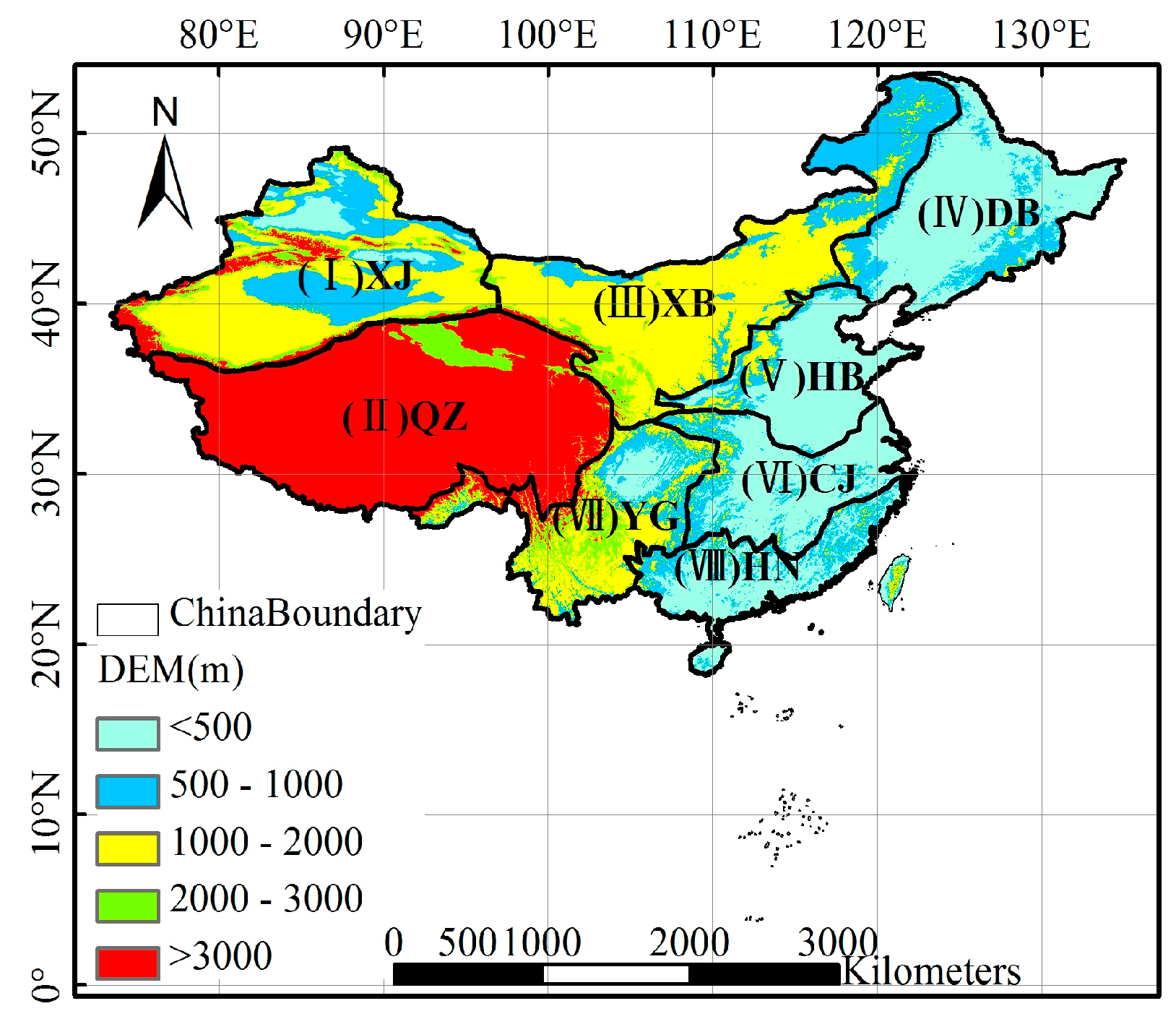
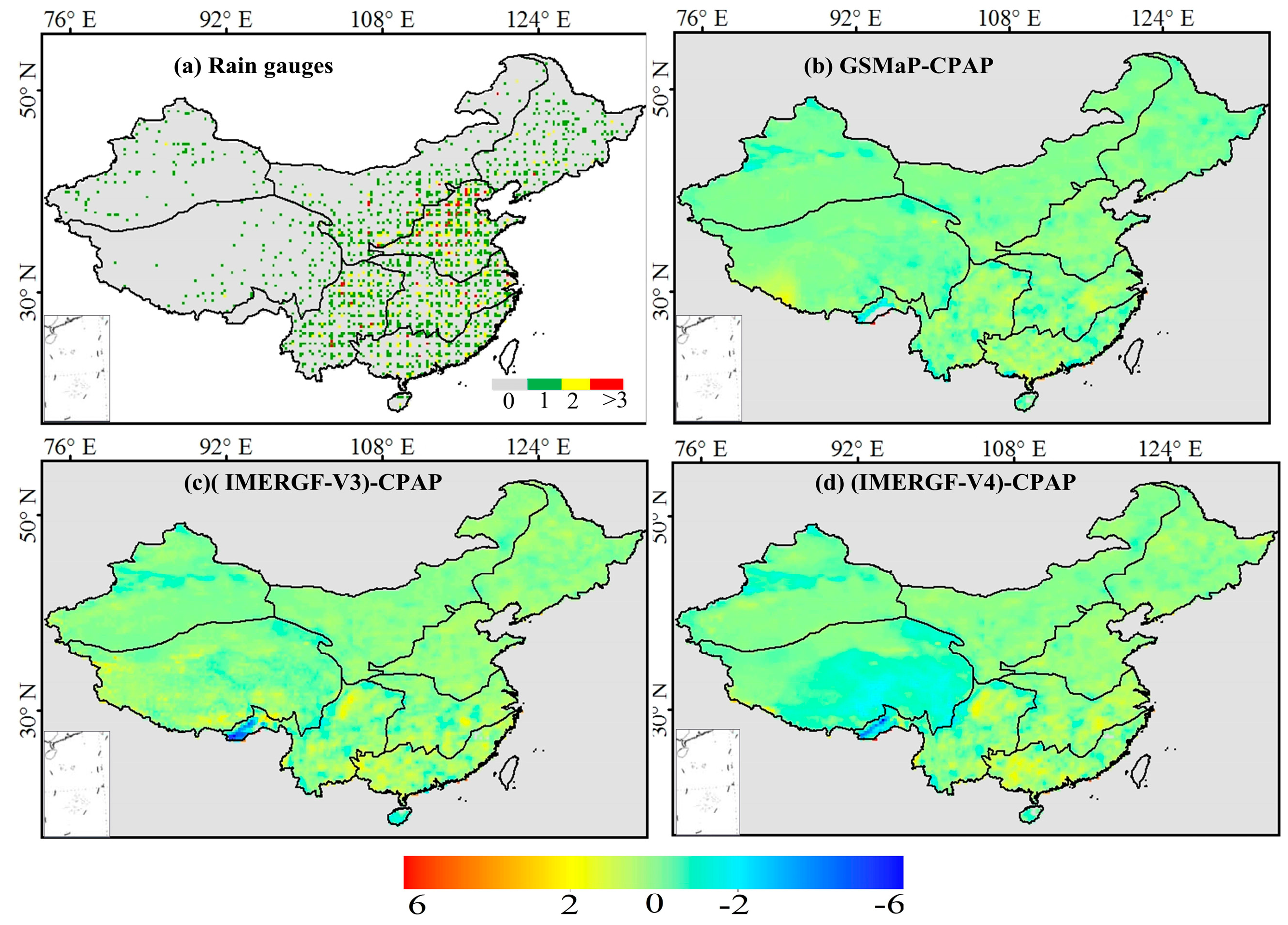

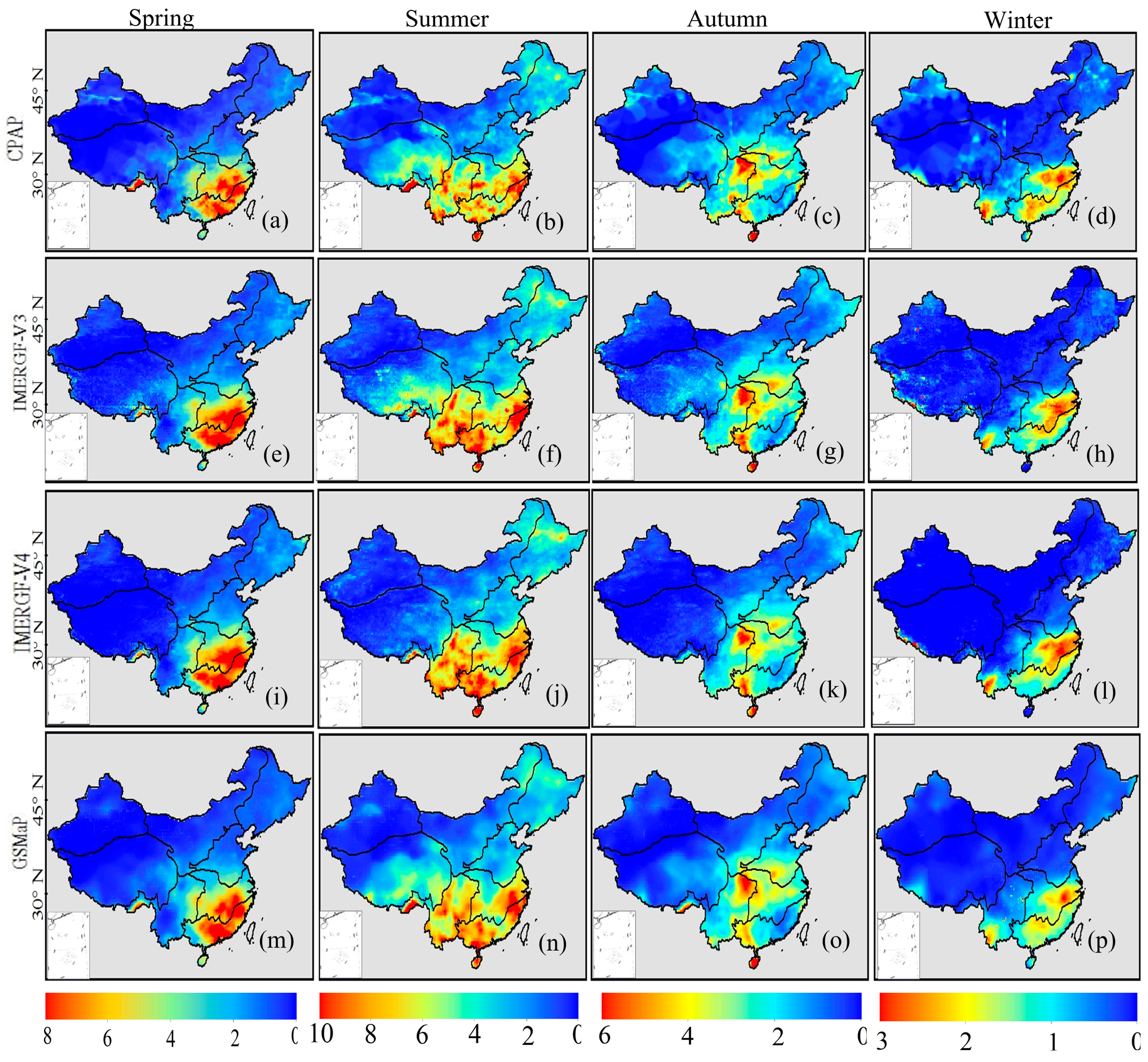
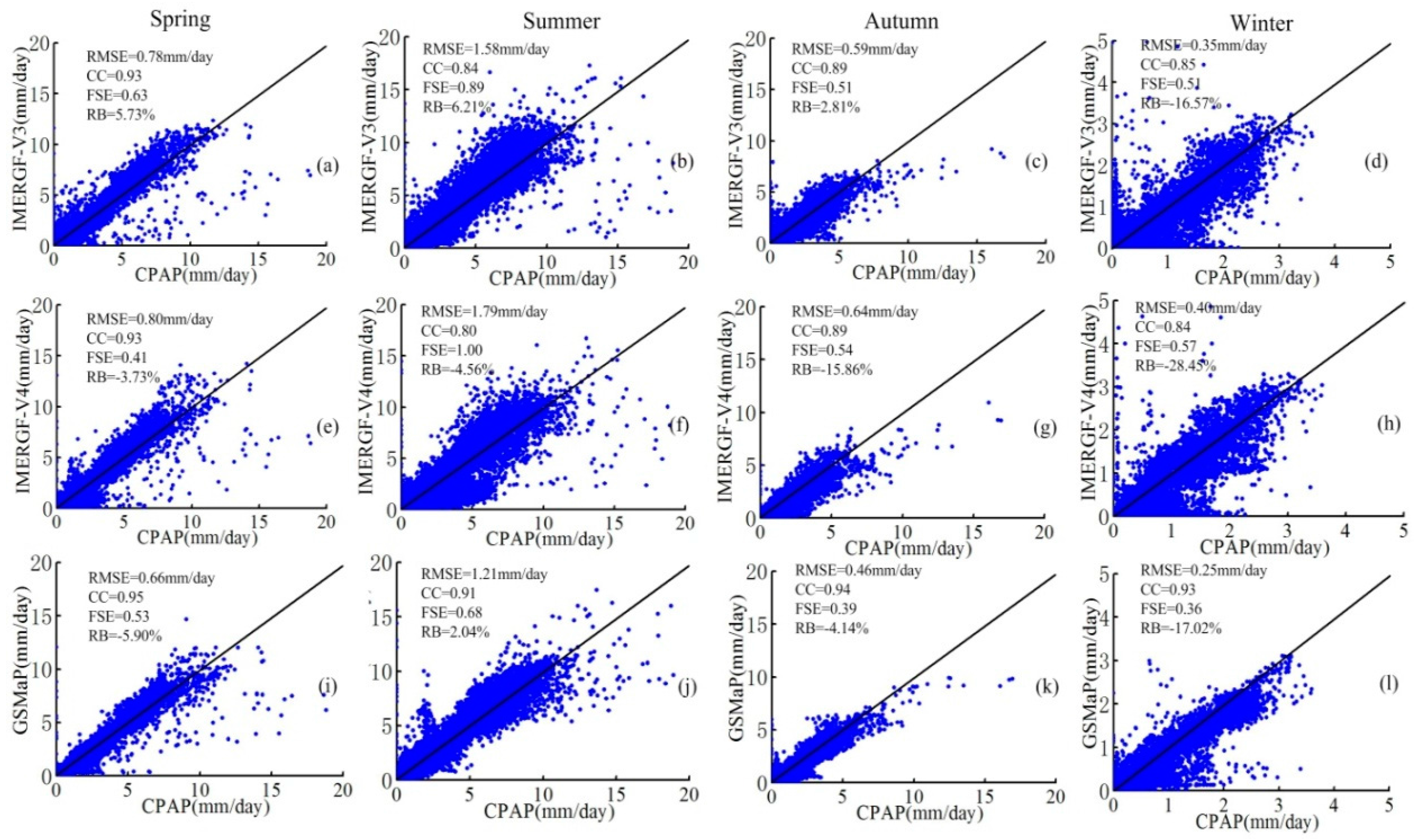
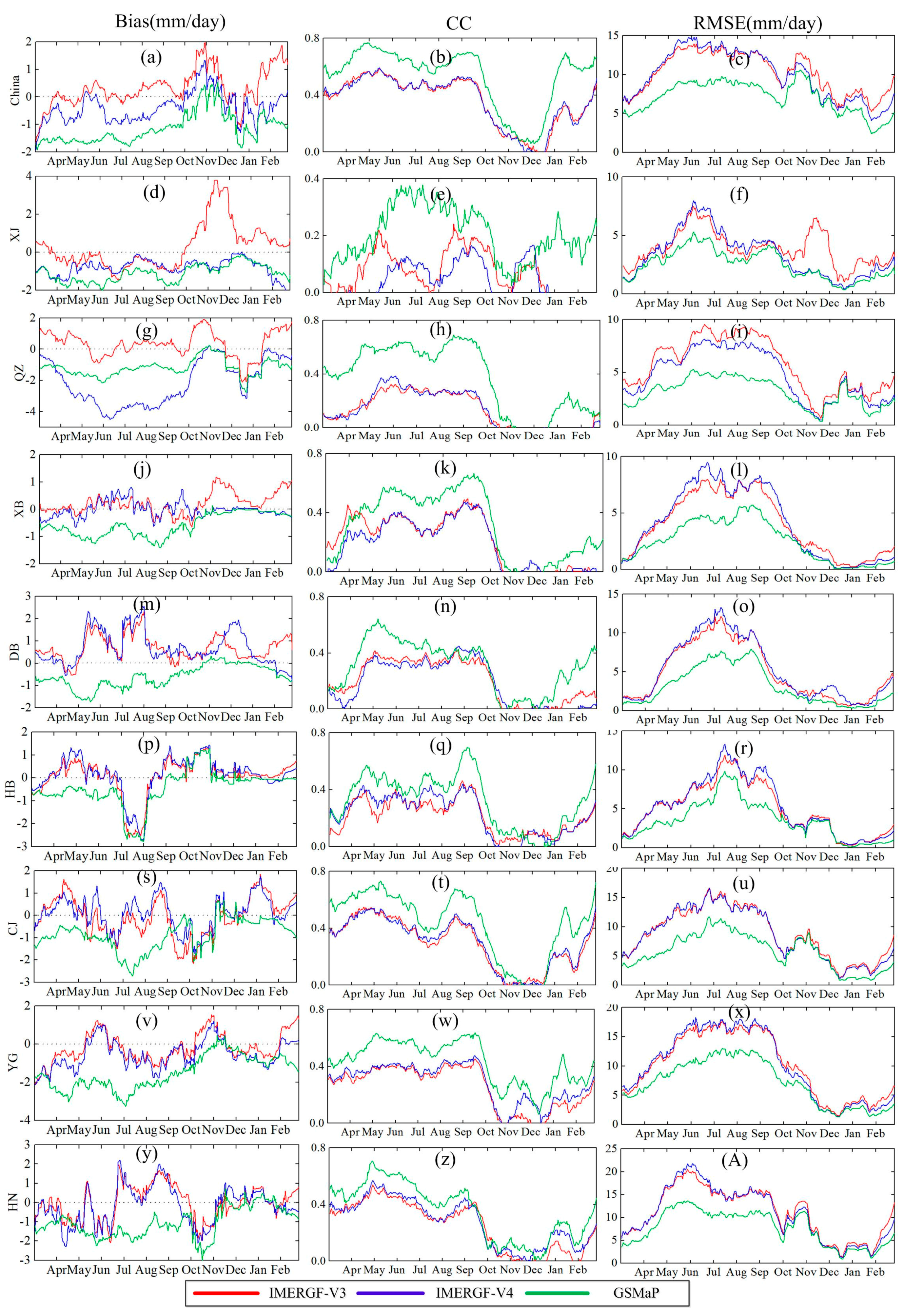

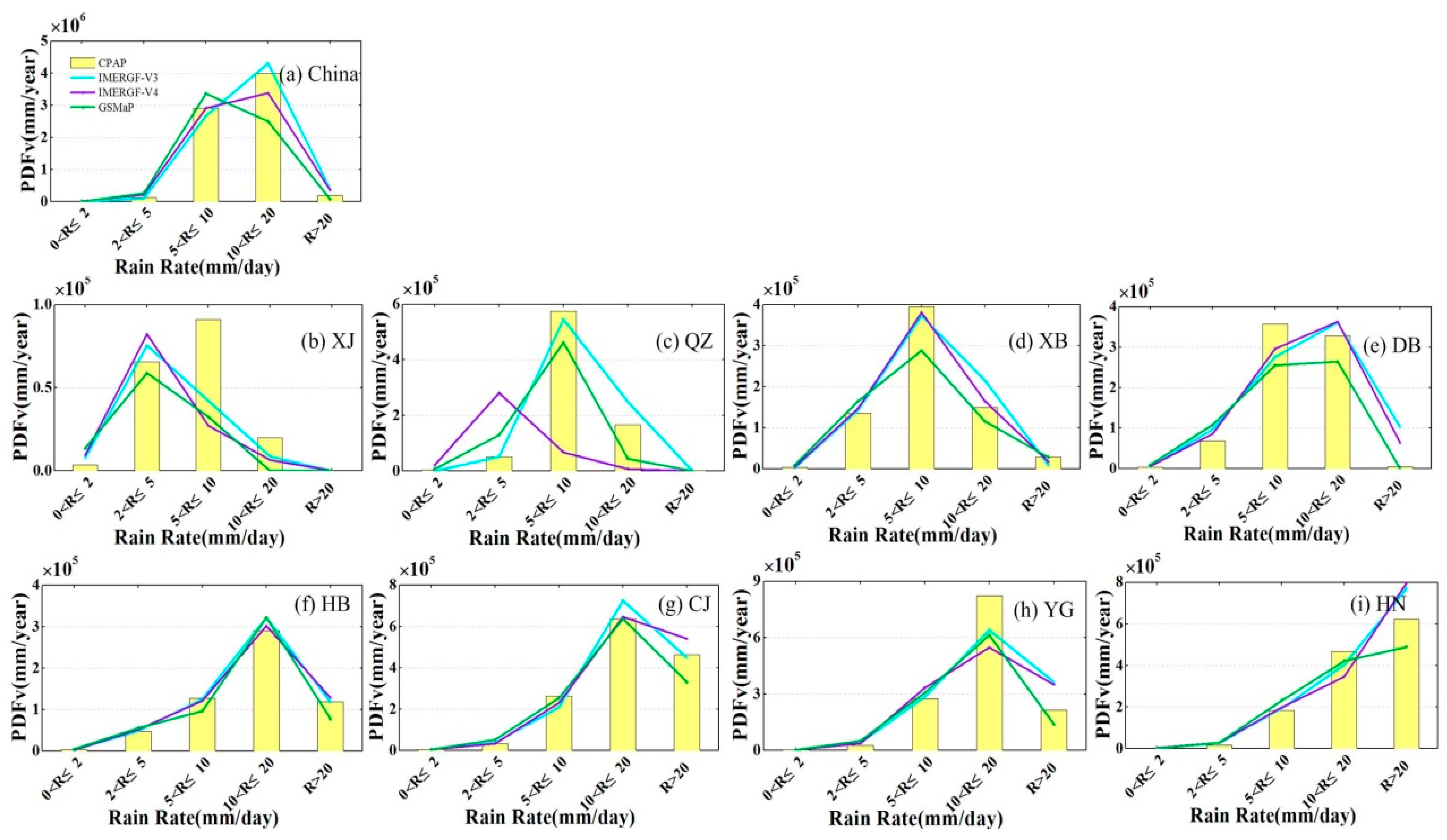
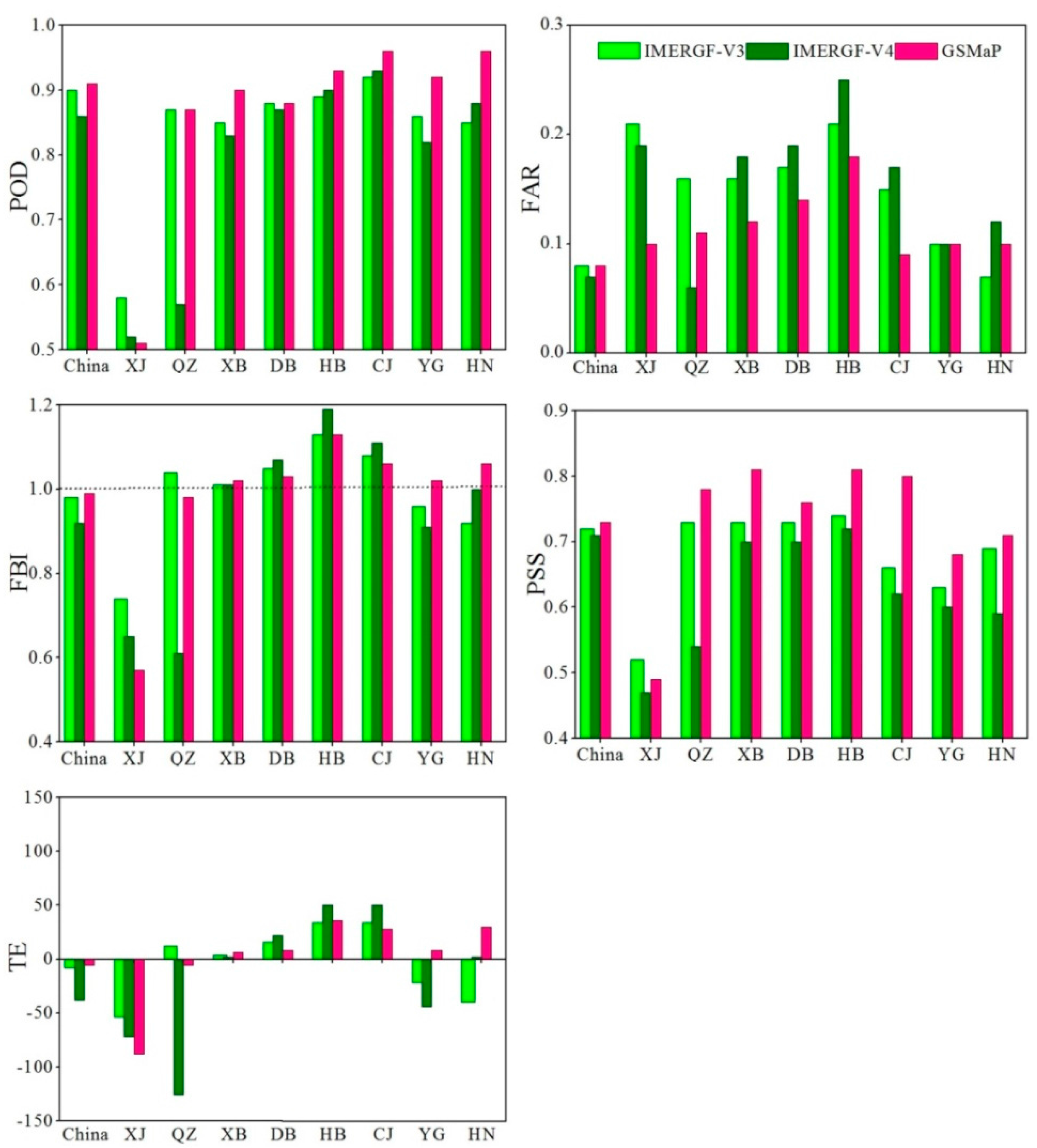
© 2017 by the authors. Licensee MDPI, Basel, Switzerland. This article is an open access article distributed under the terms and conditions of the Creative Commons Attribution (CC BY) license (http://creativecommons.org/licenses/by/4.0/).
Share and Cite
Zhao, H.; Yang, S.; You, S.; Huang, Y.; Wang, Q.; Zhou, Q. Comprehensive Evaluation of Two Successive V3 and V4 IMERG Final Run Precipitation Products over Mainland China. Remote Sens. 2018, 10, 34. https://doi.org/10.3390/rs10010034
Zhao H, Yang S, You S, Huang Y, Wang Q, Zhou Q. Comprehensive Evaluation of Two Successive V3 and V4 IMERG Final Run Precipitation Products over Mainland China. Remote Sensing. 2018; 10(1):34. https://doi.org/10.3390/rs10010034
Chicago/Turabian StyleZhao, Haigen, Shengtian Yang, Songcai You, Yingchun Huang, Qianfeng Wang, and Qiuwen Zhou. 2018. "Comprehensive Evaluation of Two Successive V3 and V4 IMERG Final Run Precipitation Products over Mainland China" Remote Sensing 10, no. 1: 34. https://doi.org/10.3390/rs10010034




